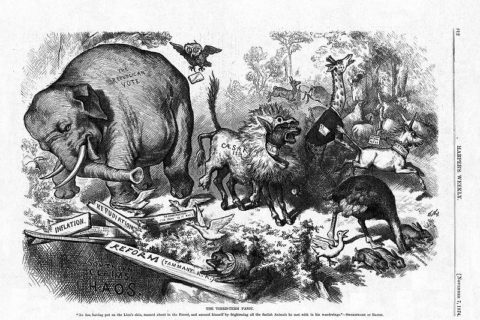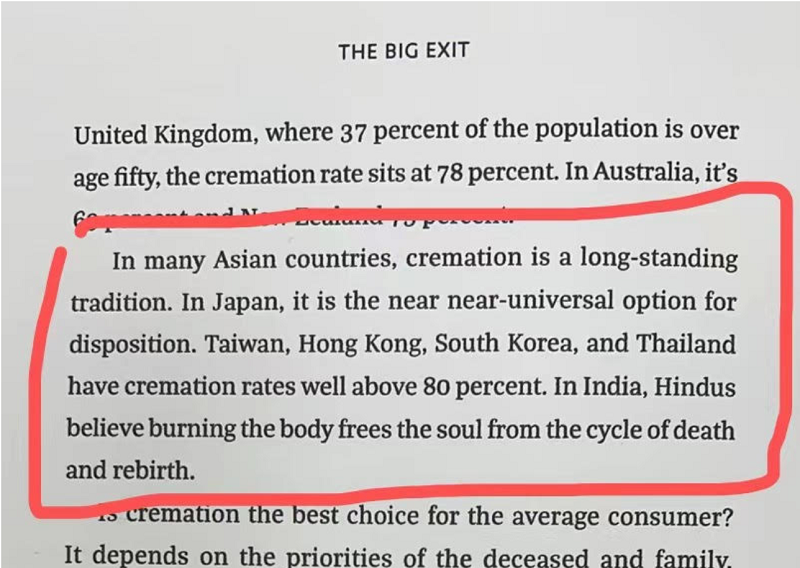… Socialists are all about equality, and if everyone ends up equally broke, hungry, and dead, well, fair’s fair. Igor Shafarevich flat out declared that Socialism is a suicide cult. Take your pick — Socialism simply is Nihilism.
That seems bizarrely wrong, considering how much effort Socialists put into saving the world. But look at it objectively, comrade (heh heh), and you’ll see that Save-the-World-ism, of whatever flavor, always boils down to Destroy-the-World-ism. Always. It doesn’t matter how the world gets “saved;” it always gets blown up in the process. You still can’t find a better primer on chiliastic psychology than Norman Cohn’s The Pursuit of the Millennium. The specifics of each loony doctrine changed, but the underlying presumption was always the same: Kill everyone, destroy everything, and then Jesus comes.
This is true even of millennialists whose doctrines don’t obviously entail killing everyone. Calvinists, for example. I spent decades trying to explain Calvinism to undergrads, and never once succeeded. The gulf between their words and their actions is too vast for the adolescent mind. There are only two logical responses to the doctrine of “double predestination”: quietism, or hedonism. They knew it, too, which is why they started burning people at the stake the minute they got any real power. Look at what they did, not what they said, and you’ll see nihilism plain as day. Calvin’s Geneva was the nearest thing to a police state that could be achieved with 16th century technology. The ideal Calvinist would say nothing, do nothing, think nothing, as he sat in the plain pews of his unadorned chapel, waiting for death and the Final Judgment. Calvinists wanted to grind the world to a halt, not blow it up, but once again the mass extinction of the human race is a feature, not a bug.
Take Jesus out of the equation, and you end up at pure shit-flinging nihilism in less than three steps. Marxism is perhaps the most exquisitely pointless doctrine ever devised. It’s more pleasant to have than to have not, I suppose, but no matter how much everyone has, we’re still just naked apes, living the brief days of our vain lives under an utterly indifferent sky. Marxists are a special kind of stupid, so they don’t realize it, but … they won. Modern Western “poor” people keel over from heart disease while fiddling with their smartphones in front of 50″ plasma tvs. While wearing $200 sneakers. We’re so far from being “alienated” from the fruits of our labor that “labor” is an all-but-meaningless concept for lots of us — and the further down the social scale you go, the more meaningless it gets. The modern ghetto dweller simply is Marx’s ideal proletarian. Does he look self-actualized to you? Ecce homeboy.
I assure you, the SJWs know this. Calvinists to the core, they know better than anyone the utter futility of all human effort. So they do what the original Calvinists did: Displace, displace, displace. Don’t take it from me, take it from a card-carrying Marxist. The end result is the same: Whether you’re a Puritan or an SJW, the only way to escape the crushing meaninglessness of your condition is to spend every moment of every day contemplating your pwecious widdle self.
Throw in the transitive property of equality, and you’ve got people like Hillary Clinton. If Socialism is Nihilism, then Nihilism is Socialism. Far from arguing against the idea … that Hillary et al are motivated solely by hatred, I’m 100% behind it. In fact, I’d argue that the Nihilism comes first — people who have convinced themselves that life is pointless always, always, embrace the biggest and most all-encompassing form of collectivism on offer. What could be crueler, than to be given all this for nothing? It’s not even a sick joke, since a joke implies a joker.
How can you not hate this world, then, and everything in it? More to the point: how can you not hate yourself, for seeing the world as it really is? Ignorance is bliss … but how can you not hate them, too, those poor deluded motherfuckers who still think stuff like God and love and family and the designated hitter might somehow mean something? Vanity, vanity, all is vanity … and if I have to face the existential horror of it all, then fuck it, so do you. “Capitalism,” the “free market,” “representative government” — call it what you will, it’s all just vanity, just another way for the sheeple to keep deluding themselves. Fuck it, and fuck them. Burn it down. Burn it allllll down.
Severian, “A Tyranny of Nihilism”, Rotten Chestnuts, 2019-10-22.
November 21, 2022
November 20, 2022
Printing books in China is economical, but also allows China to censor what you print
In the latest SHuSH newsletter, Kenneth Whyte explains why some of Sutherland House’s books are now being printed in China … and illustrates some of the risks of having them printed there:
We decided last spring to offshore some of our book printing to China (see “The Crisis in Book Publishing”, SHuSH 138). It was not a difficult decision. The difference in price is enormous.
For instance. Next week we’re releasing a book called The Prison Lady: True Stories and Life Lessons from Both Sides of the Bars by Phyllis Taylor. Presales have been strong. We need to print more copies. We can’t go back to the original Chinese printer, which charged us $2.08/copy, because it takes months to get books from Guangzhou to Toronto. We need the books now. So we shopped around. The best North American price we could find is $4.39/copy.
Why is that a problem? The book is a paperback priced at $22.95. The retailer takes half that, leaving us $11.50. After our distributor and sales agent take their fees and we pay the author her royalty, we’re left with $6.32 out of which we pay for editing, cover art, design, overhead, and shipping. And printing. If the printing bill comes to $4.39 a copy, we make no money.
Those of the economics of a straightforward paperback. A friend of mine recently called about a quote from a Canadian printer for a full-color illustrated book that came in at $15.31/copy. It seemed steep, so I sent the exact same specs to a Chinese printer who quoted $5.27/copy.
[…]
Our initial plan was to print four of our spring books in China (we’re also using printers in Turkey and India). The files for the first two of the four were delivered last month. On Nov. 7, we received the following email from the printer:
After more detailed review of some of the written content of these two books, there are some significant censorship concerns related to certain references to Taiwan, Hong Kong, and China.
As you may be aware, China vehemently enforces a “one China” principle in which Hong Kong and Taiwan are part of the “one China”. Therefore, China censorship will not allow any reference to either Hong Kong or Taiwan as its own country.
With this in mind, there is some “sensitive wording” on page 46 of The Big Exit that would not be possible to print in China due to it implying that Hong Kong and Taiwan are “countries”.
The Big Exit isn’t about politics. It’s a book about end-of-life choices or, more particularly, how we can dispose of the remains of a billion boomers over the next several decades without wrecking the planet (conventional burial and cremation are both environmentally reckless). The censorship issue arose in this paragraph, which the printer helpfully circled in bright red:
I grant that while Hong Kong still shows up in a lot of data as its own country, it is technically an administrative region of China. Taiwan’s independence is also disputed by China. Against China’s claims, we have the Frank Zappa rules of diplomacy which recognize as “a real country” any place with its own beer and its own airline. Taiwan and Hong Kong both qualify.
In any event, we are now printing The Big Exit in India.
A Conspiracy to kill America’s President? – WW2 – 221 – November 19, 1943
World War Two
Published 19 Nov 2022A torpedo attack against the President; a Marine invasion in the central Pacific that turns very bloody in a hurry; German counterattacks in the Soviet Union; a bombing raid in Italy against a secret weapons site — all of that this week.
(more…)
Cold War echoes on the Polish-Ukrainian border
In The Line, what Matt Gurney calls a “surprise fire drill” for a potential nuclear war:
Those with any memory of the Cold War probably got a bit of a cardio workout even if they were sitting still earlier this week when Polish news sources, which were quickly matched by American ones, reported that a Russian missile had landed in Poland, killing two civilians. An armed attack by Russia, in other words, on a NATO member state, even if a likely accidental one — Russia was bombing targets in Ukraine at the time and the site of the Polish blast was quite near the border with its embattled neighbour.
Still. Oops.
It didn’t take long before doubt emerged. At present, the official theory offered by Poland and accepted by NATO is that the missile that killed the two unfortunate Poles was actually a Ukrainian air-defence missile that was fired at incoming Russian missiles in self-defence. It somehow malfunctioned and landed in Poland. The Ukrainians themselves seem unconvinced and there are certainly those wondering if a wayward Ukrainian missile is a cover story to de-escalate a Russian mistake. Personally, I’d guess no. It probably was a Ukrainian missile. And if it is all a cover story in the cause of keeping tension between Moscow and the West at a low-sweat stage, I can live with that, for now.
The point isn’t for me to pretend I’m a munitions expert, capable of instantly solving the case with only the briefest glance at photos of a fragment of twisted missile debris. It’s more to consider what this event felt like, and what it easily could have been: one of the scarier scenarios Western officials and analysts have been worried since this war began nine months ago — accident kicking off a conflict neither side wanted but neither will back down from once it’s begun.
This isn’t a new fear. It was a fear during the Cold War. And a justified one. At several points during that long standoff, technical malfunctions or political miscalculations raised the danger of a nuclear war to horrifying levels. On a few occasions American defense commanders wrongly believed that the Soviets were launching an attack; luckily for everyone, the Americans had redundancies and were well trained and cooler heads always prevailed. In 1983, Soviet satellites reported the Americans were firing ballistic missiles at the Soviet Union. Tensions were high at the time and the Soviets had decided to launch a full strike on the West as soon as any NATO launches were detected. But Lieutenant Colonel Stanislav Petrov, a relatively low-ranked Soviet officer working the night shift, concluded that the warnings were probably a glitch — it didn’t make sense to him that America would open a surprise attack with a handful of missiles instead of the full arsenal. Rather than pass on a warning that would have triggered Soviet launches against NATO, he reported that the launch detections were a technical malfunction in the Soviet equipment. He did that again when further launches were detected. Lt. Col. Petrov then spent a few long and anxious minutes waiting to see if any NATO nuclear weapons exploded over targets in the Soviet Union. Waiting to see what happened was the only way the colonel could know if he’d made the right call, or a very, very bad one.
He was right, of course. It was a glitch. New Soviet satellites were being tricked by sunlight bouncing off clouds at high altitude. But for a few minutes, the fate of the world hung on one mid-ranked Soviet officer’s middle-of-the-night judgment call.
These real-life examples are horrifying. But learning of them never hit me quite as hard as the fictional scenario portrayed in the 1962 film Fail-Safe. Released around the same time as the more famous Doctor Strangelove, Fail-Safe, adapted from the novel Red Alert, was a grimly serious counterpart to Kubrick’s dark comedy. With an all-star cast that includes Walter Matthau and Henry Fonda, Fail-Safe depicts a series of small accidents that result in a group of American bomber pilots concluding that they have been ordered to conduct a retaliatory strike on the Soviet Union. There is no war. It’s entirely a misunderstanding, a fluke of American technological glitches and Soviet jamming. But the American pilots, trained to expect Soviet tricks and lies and to accept no order to abort (as such an order could be faked) relentlessly bore in on their targets, truly believing that they are avenging a Soviet strike on America.
Tank Chat #158 Spartan and Stormer | The Tank Museum
The Tank Museum
Published 22 Jul 2022David Fletcher is back with the next Tank Chat instalment! This week he chats about not one but two vehicles, Spartan and Stormer.
(more…)
QotD: The Maginot Line worked
Frontier fortifications and army bases often make a degree of intuitive sense, either aimed at controlling crossings over an entire border or protecting a military force in the field. Point defenses like walled cities or castles (or defensive systems that don’t cover the entirety of a frontier) often make less sense to modern readers and students, invariably leading to the famous misquotation of George S. Patton that, “Fixed fortifications are a monument to the stupidity of man” – what he actually said was “This [the Maginot Line] is a first class case of man’s monument to stupidity“, a comment on a particular set of fortifications rather than a general statement about them and one, it must be noted, made in 1944, four years after those fortifications were taken so we also ought not credit Patton here with any great foresight.
As an aside, the purpose of the Maginot Line was to channel any attack at France through the Low Countries where it could be met head on with the flanks of the French defense anchored on the line to the right and the channel to the left. At this purpose, it succeeded; the failure was that the French army proceeded to lose the battle in the field. It was not the fixed fortifications, but the maneuvering field army which failed in its mission. One can argue that the French under-invested in that field army (though I’d argue the problem was as much doctrine than investment), but you can’t argue that the Maginot Line didn’t accomplish its goals – the problem is that those goals didn’t lead to victory.
Bret Devereaux, “Collections: Fortification, Part III: Castling”, A Collection of Unmitigated Pedantry, 2021-12-10.
November 19, 2022
“But actually, vat ve haf to confront is ze deep, systemic, and structural restructuring of our world”
Because, as Chris Bray points out, there’s no point in restructuring the non-structural structures or something…
The G20 leaders flew to Bali this week to cosplay social repulsiveness and to hear from Klaus Schwab, who has no government position or formal place in the G20, making the G20 gathering a kind of executive committee meeting for something that rhymes with “Morld Meconomic Morum”.
The terrifyingly vacuous Bond villain said that ve must fundamentally restructure ze vorld, flattering the geniuses like Justin Trudeau and Joe Biden who will now use their personal wisdom and strength to do the restructuring.
(That’s an excerpt — the whole thing is here, if you want to punish your mind.)
There’s so much to love in this babbling, starting with the fact that the wealthiest and most powerful nations in the world can’t manage to deliver decent audio. But listen to what the man says:
1.) Looking out into an audience of the world’s major national leaders, he says that we face a global “multi-crisis”, made up of “economic, political, social, and ecological, and institutional crisis”.
Accepting the premise for the sake of argument, who caused all that crisis? Hello, leaders of the ruined world, I honor your wisdom and clarity, and turn to you to fix your broken countries that you’ve been leading.
2.) “But actually, vat ve haf to confront is ze deep, systemic, and structural restructuring of our world. Und zis vill take some time! Und ze vorld vill look differently, after ve haf gone through zis transition process.”
This is all of Klaus Schwab in three sentences: We must do structural restructuring, see, not non-structural restructuring. And after we have completely, deeply, systematically restructured literally everything in the entire world, the world will look — wait for this, because this is insight from the most renowned of all the experts, a deep mind who you may struggle to follow — different. Yes, changing things a lot makes them not be the same. Und zis is vy Klaus Schwab receives ze big bucks! You and I could not think at this level! Stand at attention!
3.) “Politically, the driving forces for this political transformation, of course, is the transition into a multipolar world, which has a tendency to make our world much more fragmented.”
Political fragmentation, then — the transition into multipolarity — causes fragmentation. The fragmentation into multipolarity makes the world fragmented, thereby, you see, fragmenting it. Careful, Klaus, you’ll accidentally write a whole Thomas Friedman column with your mouth.
The man is like a novelty gift with a pop-up clown inside it: You press the button, and it makes nonsensical streams of word-sounds. Fortunately, however, Klaus was speaking to an audience of Joe Biden, so I’m sure it sounded deep in the room.
Is this the future of budget tools?
Rex Krueger
Published 16 Nov 2022This inexpensive plane is filled with surprises and they’re not all good.
(more…)
American political parties from 1865 down to the Crazy Years we’re living through now
Severian responds to a comment about the Democrats and Republicans and how they have morphed over the years to the point neither party would recognize itself:

“The Third-Term Panic”, by Thomas Nast, originally published in Harper’s Magazine on 7 November 1874.
A braying ass, in a lion’s coat, and “N.Y. Herald” collar, frightening animals in the forest: a giraffe (“N. Y. Tribune”), a unicorn (“N. Y. Times”), and an owl (“N. Y. World”); an ostrich, its head buried, represents “Temperance”. An elephant, “The Republican Vote”, stands near broken planks (Inflation, Repudiation, Home Rule, and Re-construction). Under the elephant, a pit labeled “Southern Claims. Chaos. Rum.” A fox (“Democratic Party”) has its forepaws on the plank “Reform. (Tammany. K.K.)” The title refers to U.S. Grant’s possible bid for a third presidential term. This possibility was criticized by New York Herald owner and editor James Gordon Bennett, Jr.
Image and caption via Wikimedia Commons.
I find this extremely useful. I’d add that the postbellum parties do shift ideologies fairly regularly, as PR notes, such that even though they’re still called by the same names, they’re nowhere near the same parties, 1865-present.
I’d add some distinguishing tags for ease of reference, like so:DEMOCRATS:
The Redeemers of the “Solid South”, 1865-1882, when their main issue was ending Reconstruction and establishing Jim Crow.
The Grover Cleveland years, 1882-1896: Still primarily an opposition party, their main goal was reining in the ridiculous excesses of the Gilded Age Republicans. As one of about 100 people worldwide who have strong opinions on Grover Cleveland, I should probably recuse myself here, so let me just say this: Union Army veterans were to the Gilded Age GOP what the Ukraine is to the Uniparty now. They simply couldn’t shovel money at them fast enough, and the guys who orchestrate those ridiculous flag-sucking “thank you for your service” celebrations before pro sporting events would tell them to tone it way, way down. Cleveland spent most of his presidency slapping the worst of this down.
[How bad was it? So bad that not only did they pass ridiculous giveaways like the Arrears of Pension Act and the Dependent Pension Act — think “Build Back Brandon” on steroids, times two, plus a bunch of lesser boondoggles — but they got together every Friday night when Congress was in session to pass “private” pension bills. These are exactly what they sound like: Federal pensions to one specific individual, put up by his Congressman. Grover Cleveland used to burn the midnight oil vetoing these ridiculous fucking things, which makes him a true American hero as far as I’m concerned].
The Populist Party years, 1896-1912: They were more or less absorbed by the Populist Party — William Jennings Bryan ran as a “Democrat” in 1896, but he was really a Populist; that election hinged entirely on economic issues. They still had the “Solid South”, but the Democrats of those years were basically Grangers.
The Progressive Years, 1912-1968: They picked up all the disaffected “Bull Moose” Republicans who split the ticket and handed the Presidency to Woodrow Wilson in 1912, becoming the pretty much openly Fascist entity they’d remain until 1968.
The Radical Party, 1968-1992: The fight between the Old and New Left, or Marxism vs. Maoism.
The Boomer Triumphalist Party, 1992-2000. It’s an Alanis-level irony that Bill Clinton was the most “conservative” president in my lifetime, if the metric for “conservatism” is “what self-proclaimed conservatives say they want”. This was our Holiday From History, in which “wonks” reigned supreme, tweaking the commas in the tax code while occasionally making some noises about silly lifestyle shit.
The Batshit Insane Party, 2000-Present. The years of the Great Inversion. Today’s Democrats only know one thing: Whatever is, is wrong.
REPUBLICANS:
The Radical Party, 1864-1876: Determined to impose utopia at bayonet point in the conquered South, they started asking themselves why they couldn’t simply impose utopia at bayonet point everywhere. They never did figure it out, and we owe those awful, awful racists in the Democratic Party our undying thanks for that. This is the closest America ever came to a theocracy until The Current Year. Morphed into
The party of flabbergastingly ludicrous robber baron excess, 1876-1896. In these years, J.P. Morgan personally bailed out the United States Treasury. Think about that. FTX, meet Credit Mobilier. You guys are pikers, and note that was 1872. William McKinley deserves a lot more credit than he gets in pretty much everything, but he might’ve been the most fiscally sane American president. Only Calvin Coolidge is even in the ballpark.
The Progressive Party, 1900-1912. For all the Left loves to call Republicans “fascists”, for a time they were … or close enough, Fascism not being invented quite yet. But the Democrats coopted it under Wilson, leading to
The Party of (Relative) Sanity, 1912-1968. Before Warren G. and Nate Dogg, there were Warren G. Harding and Calvin Coolidge, the only two contestants in the “American politicians with their heads screwed on straight” competition, 20th century division. Alas, superseded by the
Anti-Left Party, 1968-2000. Want to punch a hippie? Vote for Richard Nixon. Or Gerald Ford. Or, yes, the Gipper.
The Invade-the-World, Invite-the-World Branch of the Uniparty, 2000-Present. Wouldn’t it be nice if Bill Clinton could keep it in his pants, and wasn’t a walking toothache like Al Gore? That was the essence of W’s pitch in 2000. Our Holiday From History was supposed to continue, but alas, 9/11. Some very special people at the State Department got their chance to finally settle their centuries-long grudge with the Cossacks, and, well … here we are.
By my count, the longest periods of ideological consistency ran about 50 years … and I’m not sure if that really tells us much, because it makes sense to view 1914-1945, if not 1914-1991, as THE World War, which put some serious constraints on the ideology of both sides.
Trend-wise, what I see is one side going nuts with some huge moral crusade, while the other side frantically tries to slam on the brakes (while getting their beaks good and wet, of course). Antebellum, it was the proslavery side leading the charge, but if they’d been slightly less excitable in the late 1840s, the abolitionist lunatics would’ve done the job for them by the late 1860s. If you know anything about the Gilded Age, you know that they somehow presented the truly ridiculous excesses of the Robber Barons as some kind of moral triumph; this was, after all, Horatio Alger‘s America. Progressivism, of either the Marxist or the John Dewey variety, is just moralizing gussied with The Science™, and so forth.
The big difference between then and now, of course, is that the grand moral crusade of The Current Year is open, shit-flinging nihilism. The “opposition”, such as it is, is also full of shit-flinging nihilists; they just don’t want to go before they’ve squeezed every possible penny out of the Suicide of the West. So … yeah. We’re overdue for a big ideological change. And we shall get it, never fear; we can only hope that we won’t have to see it by the light of radioactive fires.
Prelude to Victory: Burma, 1942
Army University Press
Published 11 Feb 2022In late 1941 and early 1942 the Imperial Japanese Army swept through the Asia-Pacific region like a wildfire. The Allies appeared powerless to stop them. With the British Army in Asia reeling, and pushed back to the frontier of India, something had to be done to stem the tide. “Prelude to Victory: Burma, 1942” provides context for Field Marshal William J. Slim and the 14th Army’s struggle to retake Burma from the Japanese.
QotD: Canada from the American Revolution to the Riel Rebellion
A significant number of Americans who were loyal to Britain and despised the American Revolution moved to Canada during and in the decades after the Revolutionary War. And as the number of English Canadians steadily increased along the Great Lakes and west of the Ottawa River, [Sir Guy] Carleton created what became the province of Ontario, Upper Canada, in 1791. The first lieutenant governor, John Graves Simcoe, devised and implemented an ambitious program of enticing Americans to Canada by effectively giving them rich farmland. The population of English Canada rose swiftly toward parity with the French. In 1792, Simcoe took it upon himself to abolish slavery in Upper Canada, 42 years before this was done in the British Empire, and 71 years before the United States. It was an admirable and pioneering endeavour in the principal area of civil rights controversy in North America in the coming century.
Unfortunately, as the Revolutionary and Napoleonic wars unfolded, the British could not resist the temptation to employ their mastery of the high seas to impose blockades and harass the shipping of neutral powers. The young United States did not have the military force to deter such treatment, and in 1812 those countries went to war. Canada was the blameless focal point of most of the fighting. Canada with the continuing solidarity of the French-Canadians, was able to mount a very solid defense. The many thousands of recently arrived Americans did not support the United States and the generous policy of enticing settlement from the United States was completely vindicated. There were pressures to expel them, monitor them, disqualify them from holding local offices and positions. But it was soon agreed that they could become citizens after eight years of residency. This affected about 40 percent of English-Canadians and this must count as another very successful chapter in Canada’s early record of respect for civil and human rights.
As reasonably successful wars do, considerable national sentiment was created and encouraged by the successful joint struggle to avoid American occupation. Out of these experiences came increased ambitions for democratic self-rule in domestic matters as the British and Americans enjoyed, instead of autocratic rule by British governors. Canada’s position was complicated by the fact that it could not agitate for home rule too energetically or the British would lose patience and sell Canada to the United States for cash or other territory or for a comprehensive alliance. Outright rebellion was not an option for Canada as it had been for the Americans, as the United States would seize Canada if it were not under British protection.
The Canadian solution for agitating but not completely exasperating Great Britain was the Gilbert and Sullivan rebellions of 1837 led by William Lyon Mackenzie in Ontario and Louis-Joseph Papineau in Québec. The Ontario uprising was just a rowdy group of malcontents who became disorderly and were easily chased off, and the French-Canadian group were essentially pamphleteers, though there were some exchanges of fire and small rebel and military units marched to and fro in poor winter weather. A total of about 300 people died, there were 14 executions and 92 people were transported as prisoners to Australia. The rebel leaders fled but were eventually pardoned and returned.
There was enough commotion to get Britain’s attention, but the loyalty of most of the population gratified the British, and they determined to put things right. London sent the well-known reformer Lord Durham to Canada in 1840 to make recommendations. After a year of research by a couple of biased examiners, Durham came to the insane conclusion that the source of Canadian discontent was that the French-Canadians wanted to be relieved of the intolerable burden of being French. Durham proposed uniting Upper and Lower Canada and assumed that the slight resulting English majority would assimilate the French in about 10 years. Of course, this was precisely what the French feared, and the English-Canadians had no desire for it either. But after several years of rearguard action by British governors, the movement for autonomous government succeeded, after the 25-year-old Queen Victoria sent Lord Elgin to Canada as governor to give the Canadians what they wanted. Elgin and Robert Baldwin and Louis-Hippolyte LaFontaine achieved this and secularized a great deal of territory owned by the principal churches so that they could be more easily settled and made the principal universities officially nondenominational. These were again great and non-violent steps in the civil rights of Canadians who now numbered over two million people.
All of North America was now walking on eggshells over the immense problem of American slavery. Slavery was abolished throughout the British Empire in 1834. In practice, there had not ever been more than a couple of hundred slaves in Canada, apart from the natives enslaving each other. Slaves had been imported to the southern states because of their efficiency at harvesting tropical crops such as cotton, so Canada was effectively spared that horrible institution, because of its climate more than its virtue. Canada consistently had a fine record in accepting about 40,000 fugitive slaves that reached the Canadian border in the thirty years before the U.S. Civil War. The leading American anti-slavery advocates Harriet Tubman and John Brown, and Josiah Henson, the model for the chief character in Harriet Beecher Stowe’s novel Uncle Tom’s Cabin, which sold an unheard-of two million copies in the 1850s, all lived in Canada for years. There were at least 11 black Canadian doctors who were fugitive slaves or sons of fugitive slaves who served in the Union Army in the Civil War, and the white Canadian anti-slavery activist, Dr. Alexander Ross, at the request of President Lincoln, assisted in breaking up a Confederate spy ring in Montréal. Escaped slave Joseph Taper, of St. Catharine’s, wrote this letter back to his former and still putative owner in 1839: “I now take this opportunity to inform you that I’m in a land of liberty, in good health … In the Queen’s dominions, man is as God intended he should be; all are born free and equal, not like the southern laws, which put man on a level with brutes. All the coloured population is supplied with schools. My boy Edward, who will be six years next January, is now reading and I intend keeping him at school until he becomes a good scholar. My wife and self are sitting by a good comfortable fire, happy, knowing that there are none to molest us or make us afraid. God save Queen Victoria.”
As many as 40,000 Canadian volunteers served in the Union Army in the Civil War and Canada was thanked on several occasions by President Lincoln for infiltrating Confederate exile organizations. This was an issue in which all Canadians were united and is a legitimate matter of national pride.
The next major civil rights challenge that Canada had to face was that of the Métis — the mixed white and indigenous people on the Great Plains of Canada. The territory of the natives had been steadily reduced by white settlement and the nutritious content of their diet had been reduced by the heavy depletion of the herds of plains Buffalo. There were also many other grievances and undoubtedly a number of violations of the Indian treaties and of the Indian Act and a flamboyant Metis lawyer, Louis Riel, led an uprising on the western plains in 1878. This was eventually suppressed with little violence, as Prime Minister John A. Macdonald dispatched an adequate military force under Field Marshal Garnet Wolseley, Gilbert and Sullivan’s “very model of the modern major general”. Riel fled to the U.S. and the Canadian government made a number of useful concessions to the aggrieved natives. But in 1885, Riel returned and led a rebellion in northwest Saskatchewan. At the same time, the Canadian Pacific Railway ran out of money and was about to flounder into bankruptcy. Macdonald brilliantly sent Canadian forces West on the railway and they surprised and defeated the insurgents and captured Riel. By emphasizing the railway’s role in saving the country (as Riel was making both annexationist and secessionist noises), Macdonald won passage of a bill to finance completion of the railway. Macdonald also gave the natives the right to vote and rewarded his allies among the native leaders. However, he created a lasting grievance by allowing the execution of Riel. Although 15 people died in the uprising, he should have commuted the sentence for insanity — Louis Riel was delusional.
Conrad Black, “Canada’s excellent history of civil and human rights”, New English Review, 2022-08-18.
November 18, 2022
“WOLLT IHR DEN TOTALEN TWEET?“
When German public TV is willing to invoke literal Nazi imagery, you know the Twitter situation has gotten out of hand:
After Germany’s “first” public television network, ARD, compared Elon Musk reducing Twitter censorship to “letting rats out of their holes”, Germany’s “second” public television network, ZDF, has now compared Musk to Nazi Propaganda Minister Joseph Goebbels! (The network’s name Zweites Deutsches Fernsehen literally means “Second German Television”.)
Thus, last Friday, ZDF’s would-be comedy program, the “Heute Show”, posted the below tweet and photoshop.
The Tweet reads: “Thanks to Elon Musk, you’re allowed to say anything again on Twitter! Total freedom of speech! #heuteshow.” The caption, whose color scheme and font invoke Nazi-era propaganda, reads “Do you want total tweet?” It is an allusion to Goebbels’s 1943 speech at the Berlin Sportspalast, in which the Nazi Minister of Propaganda famously shouted, “Do you want total war?” – in response to which audience members leapt to their feet shouting “Yes!” and raising their arms in the Hitler-salute.
The background image appears to show a Nazi Party rally with the swastikas replaced by the Twitter bird logo. Two smaller swastikas are still visible in the lower left-hand corner of the full-size image.
Leaving aside the extreme mental contortionism required to associate freedom of speech with Nazi Germany, if ever there was a don’t-throw-stones-in-glass-houses moment, this was it. For, as so happens, during the Second World War, the founding director of ZDF, Karl Holzamer, himself served in one of the propaganda units that none other than Goebbels’s Ministry of Propaganda embedded with the different divisions of the Germany military.
Holzamer served in a propaganda unit of the Luftwaffe or German air force. As noted in a 2012 article titled “Goebbels’s Soldiers” in the German daily Die Frankfurter Rundschau, Holzamer was embedded with the Luftwaffe during its April 1941 bombing of Belgrade and was “the first” to report on the German subjugation of the Yugoslav capital.
Baltic Peoples Join the SS – War Against Humanity 087
World War Two
Published 17 Nov 2022Hitler forces Himmler to betray his promise of independence for the Baltic states, despite giving the Waffen-SS 40,000 of their young men. Ion Antonescu of Romania decides to save the remaining Romanian Jews to save his own ass.
(more…)
“There are no solutions. There are only trade-offs.”
Parenting babies and toddlers, as Jen Gerson can tell you in disturbingly graphic detail, requires a totally revamped view of what an acceptable level of hygiene and cleanliness might be compared to those blissful days pre-parenthood … and that was before Canada’s public healthcare system began sinking under the weight of the pandemic:

“Covid 19 Masks” by baldeaglebluff is licensed under CC BY-SA 2.0
Ask any parent of a small child right now and you’ll get much the same tale of woe. We’re in the trenches, man. The illnesses have been utterly relentless since school began. We’ve seen nothing like it before; it’s as if three years of sicknesses are being crammed into three months.
So while we’re stressed out, grumpy, and annoyed, we’re not surprised that the shelves are bare of basic children’ medications, and the hospitals are overwhelmed. This was all entirely predictable — and was, in fact, predicted.
That’s why Moore’s advice, to mask up in the Stage 4 biohazard that is my own home, was responded to with an instant eye roll. It was the type of well-intentioned advice that I completely discounted as out of touch and impractical — which is how we used to regard quite a lot of public health advice in the Before Times. “This is a very fine sentiment, but has no relationship to the world in which people actually live.”
Sorry, my little girl just coughed into my mouth.
Moore’s announcement felt like a trial balloon for the return of mask mandates in Ontario in the hope of offsetting the effects on pediatric ICUs, which are currently being overrun by sick children. (The government has thus far not imposed a mandate or even hinted that it may, but you know Ford and his sudden reversals.) Federal public-health officer Theresa Tam has already suggested we mask indoors — but has also stopped short of mandates.
I admit, seeing this from afar, I was struck by two entirely contradictory emotions, neither of them positive.
The first, as better articulated by one of my good friends and fellow mom-in-arms was: “Jesus, we shut down the entire world for two years to save the lives of the elderly, and now that the kids are getting sick, it’s like pulling teeth to get anyone to accept even the most moderate, least intrusive measure — masking.”
The other emotion, equally intense and angry, is the exact opposite of this sentiment: My daughter needs to build an immune system. She needs to be exposed to germs, bacteria, bugs and illnesses. That can’t be avoided. It can only be further delayed.
If the current wave of extraordinary pediatric illnesses is the entirely predictable result of three years of social isolation, lockdowns, school cancellations and, yes, masking, then how will more of any of this help matters in the long run? All we’ll be doing is spreading out the pain over a longer period of time. Non-Pharmaceutical Interventions are sometimes necessary, but truer words were never spoken than these: “There are no solutions. There are only trade-offs.”
Both of these sentiments are rooted in the same, bone-deep mommy anger. This pandemic, and our response to it, has revealed a profound intergenerational inequity that demands redress. Once again, our kids are paying the bills, literally, figuratively, and physically.
The Model SS41 – A Czech Bullpup Anti-Tank Rifle for the SS
Forgotten Weapons
Published 23 Jun 2017The SS41 was a bullpup, bolt-action antitank rifle manufactured in small numbers by CZ for the SS. Contrary to common assumption, the SS were not a part of the standard German military arms procurement system, and were forced to scrounge for their weapons from other sources. Czech factories were one of the more popular sources, as smaller production lines could escape being integrated into Wehrmacht oversight and were able to contract privately with groups like the SS (the ZK383 as used by the SS is another example of this).
The Model 41 had been in development by the Czech military when the Germans occupied, and it was adapted to the German Patrone 318 cartridge for this production run. That cartridge was also used in the PzB-39, and fired a 220 grain tungsten-cored bullet at 4000 fps — although even this extremely high velocity only allowed it to defeat 30mm of vertical armor at 100m. As with the other antitank rifles of WW2, it would obsolete almost as soon as it was introduced, although it did remain useful for attacking emplaced positions and light armored vehicles (much like the Soviet PTRD and PTRS rifles).
Only a few thousand of the SS41 were manufactured, and they served primarily on the Eastern Front. As a result very few exist in American collections, and this is a particularly excellent example. Thanks to the Institute of Military Technology for allowing me to have access to this very cool AT rifle and bring it to you! Check them out at:








